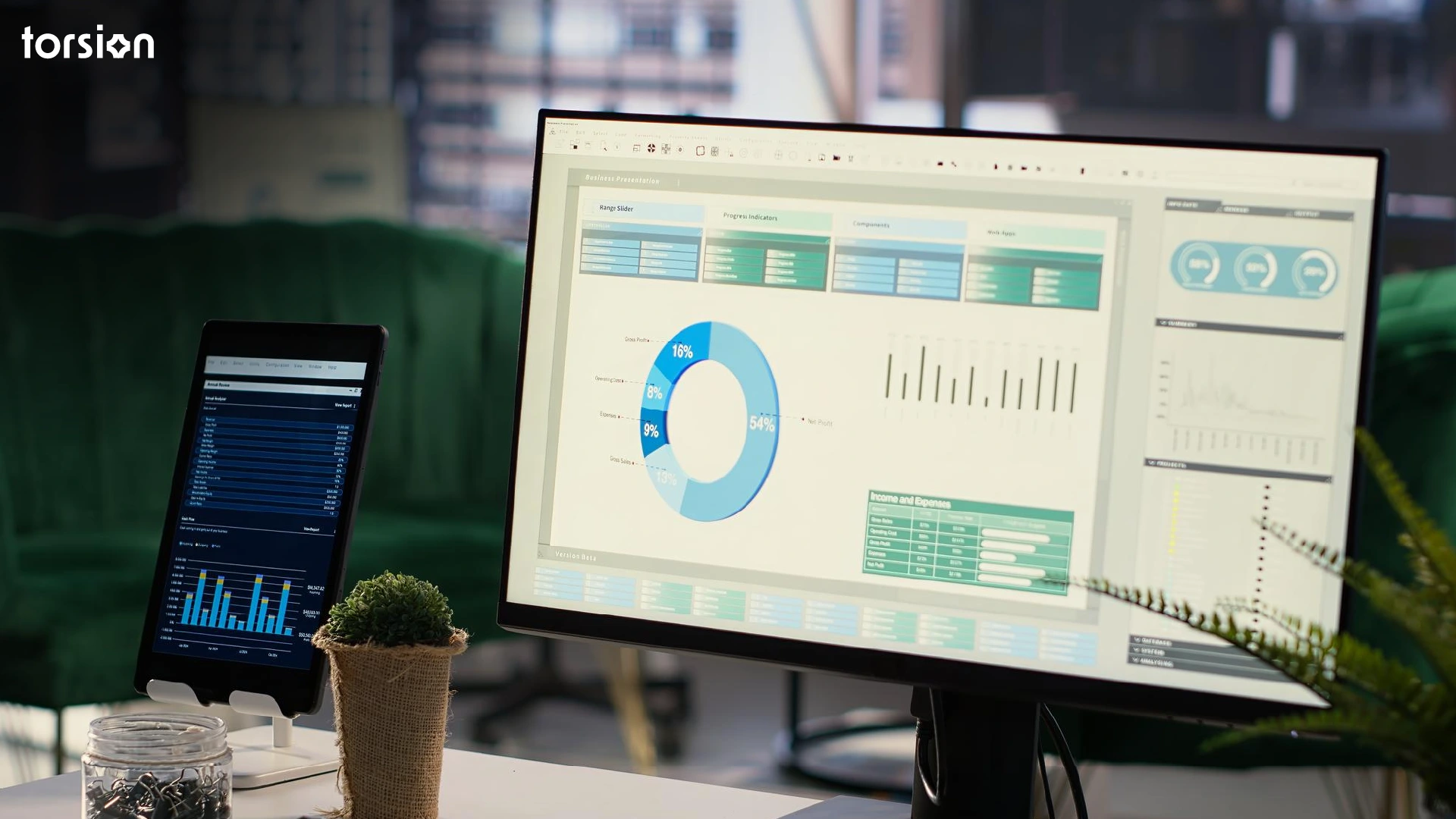Key Takeaways
- MLOps assumptions fail under LLM complexity in payer workflows
- Prompt behavior, not just model performance, must be operationalized
- Token-based costs require real-time monitoring and routing
- Compliance, auditability, and explainability need system-level support
- LLMOps maturity is built in phases—not plug-and-play
- Future-ready payers will lead with proprietary orchestration and policy-aware AI
A member calls to check on a denied claim. The chatbot sounds polite, confident, and even helpful.
But what was seemingly a routine call turned into something else. Because by the end of the call, the member believes they’re no longer eligible for benefits. When in fact they were.
The large language model hallucinated a clause that doesn’t exist. No alerts were sound or exceptions raised. The system functioned perfectly at face value but not in reality.
This is the new frontier healthcare payers are walking into.
For years, MLOps held firm. Models were trained on static claims data, validated against historical adjudication patterns, and monitored for drift using clear thresholds. But LLMs don’t behave like claims models. They are meant to interact and in healthcare, that interaction comes with regulatory teeth.
In the world of prior auth automation, policy summarization, and member service triage, LLMs bring unprecedented capabilities, while also introducing contextual volatility. A slight prompt variation can trigger a different medical necessity explanation. A tone shift can yield a different interpretation of a benefit policy.
These are operational blind spots.
The fact is traditional MLOps weren’t built for this. It can’t track conversational state across sessions. It can’t audit semantic drift in generated text. And it certainly can’t guarantee regulatory compliance when outputs change subtly over time.
LLMOps really is about rebuilding the entire operational layer, instead of optimizing the existing one, with safety, behavior, and interpretability baked in from day one.
The Technical Debt Crisis: Why Classical MLOps Fail in the LLM Era?
Traditional MLOps fails in healthcare LLM deployments due to architectural mismatches. Batch pipelines, static features, and linear degradation assumptions can’t support dynamic, real-time LLM behavior. LLMOps addresses prompt drift, context continuity, emergent capabilities, and multi-modal orchestration, critical for payers navigating compliance, trust, and conversational AI complexity in production systems.
Healthcare payers are realizing that MLOps principles break down when applied to LLMs. These models behave unpredictably, shift with context, and demand real-time, behavior-driven operations. LLMOps steps in to handle prompt drift, memory management, and multi-modal data—core to ensuring safe, compliant AI interactions in complex, regulated environments like healthcare.
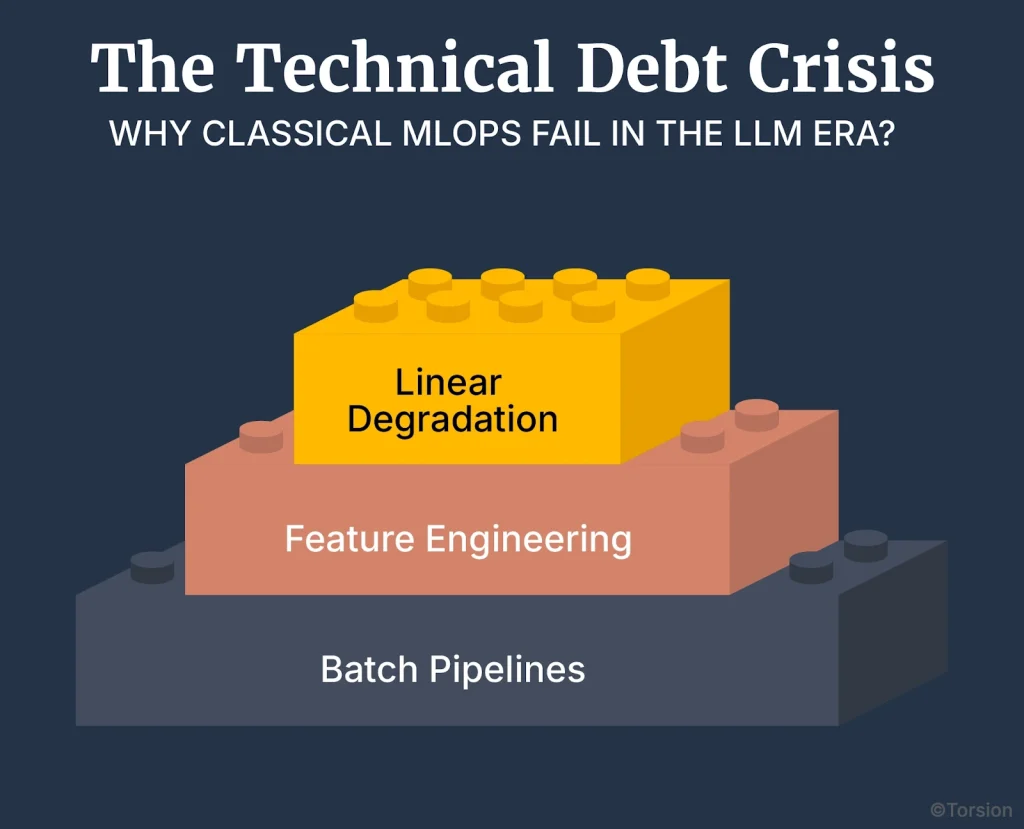
Healthcare payers have invested years building MLOps infrastructure including pipelines, monitoring, and retraining loops, all designed around structured data and predictable outputs.
But large language models don’t play by those rules.
They reason, improvise, and sometimes invent. That makes them powerful and dangerous at the same time, especially if you’re still operating under the wrong assumptions.
And that’s the real problem. It’s not your infrastructure that’s failing. It’s the operational philosophy behind it.
Batch Pipelines Work for Everything
Reality for Payers: Conversations are stateful, real-time, and regulatory
MLOps is built for stability such as ETL jobs, batch updates, retraining schedules. But LLMs live in real-time. When a member chats with an agent on Monday and follows up by voice on Thursday, you need that entire context preserved, interpreted, and acted on. This is a conversation which classical ops can’t handle.
Feature Engineering is King
Reality for Payers: Prompt Engineering is the system
In MLOps, the input space is well-defined—features are engineered, models consume them. But with LLMs, prompts carry semantics, tone, and regulatory nuance. A single-word tweak can change whether an explanation sounds compliant or problematic. Prompt engineering is therefore the core operational artifact.
Models Degrade Linearly
Reality for Payers: LLMs behave emergently
A slight uptick in model loss? A trigger for retraining. That’s MLOps. But in LLM systems, a stable model can suddenly start interpreting policy documents differently because the prompt changed, or the user context shifted. This is the emergent nature of language models at scale.
The Hidden Complexity Tax Nobody Budgeted For
And even once you adapt to these philosophical mismatches, a new layer of operational debt surfaces:
- Prompt Drift Detection
Token diffing won’t cut it. You need semantic-level alerting because the meaning, not just the wording, defines risk. - Context Window Management
Member histories, prior decisions, and case notes must travel with the session. Otherwise, continuity breaks and so does trust. - Emergent Capability Monitoring
Your model may start generating logic for policy clauses it was never fine-tuned on. In payer operations, that becomes liability. - Multi-Modal Complexity
It’s not just text. LLMs now interface with EOB images, policy PDFs, even speech-to-text transcripts. Synchronizing those streams becomes an important aspect of orchestration.
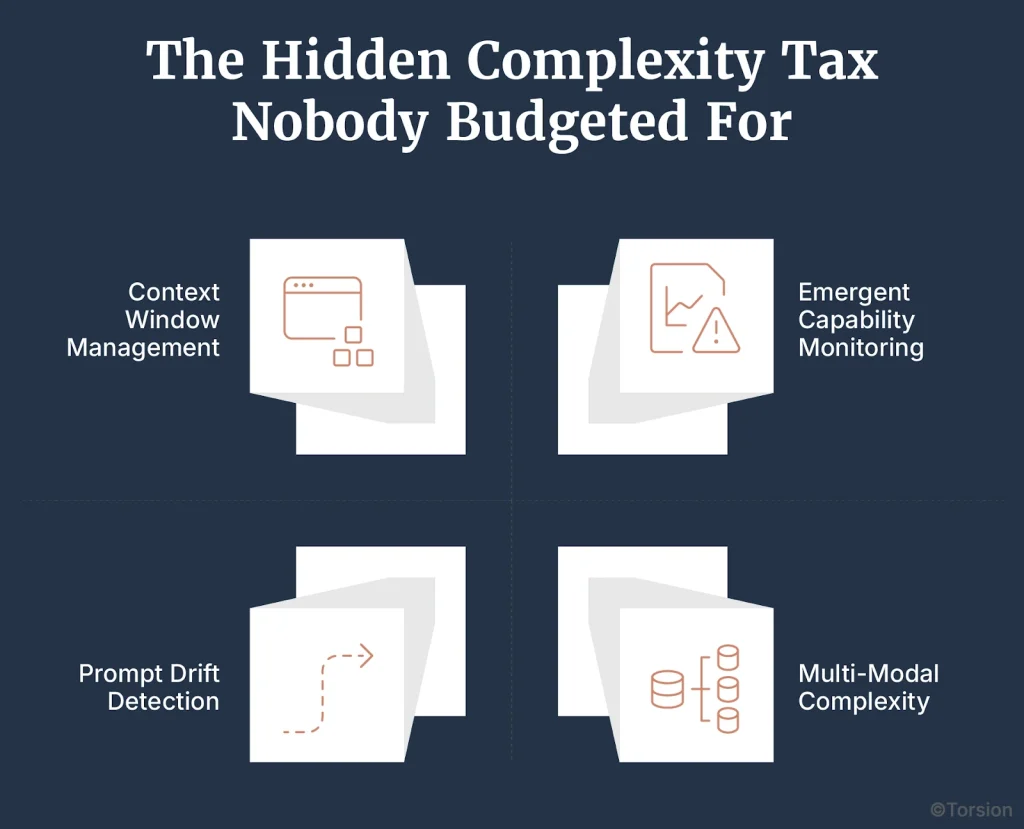
So let’s be clear. We aren’t telling you to optimize your MLOps stack. It’s about admitting that the stack is no longer the point. LLMs force you to operationalize behavior and in healthcare, behavior has to be provable, repeatable, and aligned with compliance every time.
LLMOps Architecture: How Can You Engineer for Emergent Intelligence?
LLMOps replaces traditional MLOps for healthcare payers managing language models. It focuses on prompt versioning, multi-modal data handling, real-time behavioral monitoring, and cost-aware inference. These capabilities ensure accurate, compliant, and explainable outputs across member interactions. LLMOps is critical for trust, scalability, and regulatory alignment in production-grade payer environments.
Healthcare payers can’t rely on old MLOps tools for LLMs. They need infrastructure that tracks prompt behavior, coordinates messy data, and flags hallucinations before they become compliance risks. LLMOps delivers this—ensuring LLMs don’t just sound confident but stay accurate, fast, and safe. In regulated environments, that’s the difference between automation and audit failure.
Let’s say you’ve accepted the premise: MLOps, as we know it, doesn’t hold up.
So now what?
You can’t just bolt on a prompt layer and hope for the best. LLMs aren’t just bigger models. They behave differently. They misbehave differently too.
For healthcare payers, that behavior matters. Because every output whether it’s a benefit explanation, a denial rationale, or a chatbot response, it carries regulatory weight. One wrong sentence, and you’re in audit territory.
This isn’t about squeezing more juice from the same pipeline. It’s about building a new kind of stack. One that’s flexible, observable, and built to handle systems that evolve mid-conversation.
Below are the four pillars that support that stack. Not theoretically. In production. Under load. Inside real payer workflows.
Prompt Management Systems
This is your control plane. Not a sidecar.
The simpler way to look at prompts is as inputs. The deeper, and more necessary way to look at them, is behavior triggers. In LLM systems, what you write is what you operationalize. If you don’t version, monitor, and analyze prompts like software, you’ll never catch drift until it shows up in a CMS audit.
What you need
- Semantic diff tracking. Know what changed and what changed because of it.
- A/B prompt testing across member journeys.
- Context injection based on claims, geography, and plan tier.
- Live analytics: hallucination rate, sentiment skew, tone compliance.
Payer reality: Your model said “not covered due to prior auth failure.” But the real reason was plan exclusion. That’s a compliance miss.
Multi-Modal Data Orchestration
Your inputs don’t live in a CSV anymore.
A claim lives in structured fields. The explanation lives in a PDF. The appeal comes through a chatbot. Your LLM needs to ingest, align, and remember all without losing fidelity.
What you need:
- Preprocessors for scanned EOBs, portal notes, HL7 packets.
- Validators to catch when summaries contradict source documents.
- Adaptive routing because not all inputs belong on the same path.
- Semantic memory that carries over session state, securely.
Payer reality: A member asks, “Why was this denied?” and the model doesn’t remember last week’s case note. You’ve lost continuity and trust.
Inference Optimization Engines
Tokens cost money. Latency costs trust.
Your members don’t care how smart your model is. They care how fast it responds. And your CFO cares how much that costs. Every word out of an LLM burns tokens and budget.
What you need:
- Speculative decoding. Start guessing before the model’s done thinking.
- Dynamic batching, tuned to token count, not just request type.
- Sharded inference for horizontal scale.
- Token-aware cost projection. Know the bill before the API call.
Payer reality: You can’t spend GPT-4 money answering CPT code lookups. But you also can’t stall member support in open enrollment. You need routing intelligence. Now.
Behavioral Monitoring & Guardrails
Accuracy is just the floor. Behavior is the ceiling.
LLMs don’t fail like classical models. They get weird. They get persuasive. And sometimes, they get it mostly right, which is even worse.
What you need:
- Hallucination scoring with retrieval-based fallbacks.
- Bias drift detection by ZIP code, language, claim type.
- Prompt injection detection (yes, even from members).
- Circuit breakers that escalate to humans when confidence drops.
Payer reality: If your model fabricates a medical necessity clause, that’s not “a bug.” That’s a lawsuit waiting to happen.
The Economics of LLMOps: How Do You Optimize the Token Economy?
LLMOps shifts cost from compute to conversation. For healthcare payers, every token carries financial and regulatory weight. Key cost levers include prompt routing, semantic caching, and real-time complexity analysis. Hidden costs like state tracking and audit logging, require architectural foresight. LLMOps delivers cost control and compliance by design, not after the fact.
LLMs generate answers and invoices. In healthcare, where every interaction is long and loaded with risk, payers must optimize not just for performance, but for token economy. Smart routing, caching, and context shaping keep budgets in check. With the right stack, LLMs scale safely without the financial surprises.
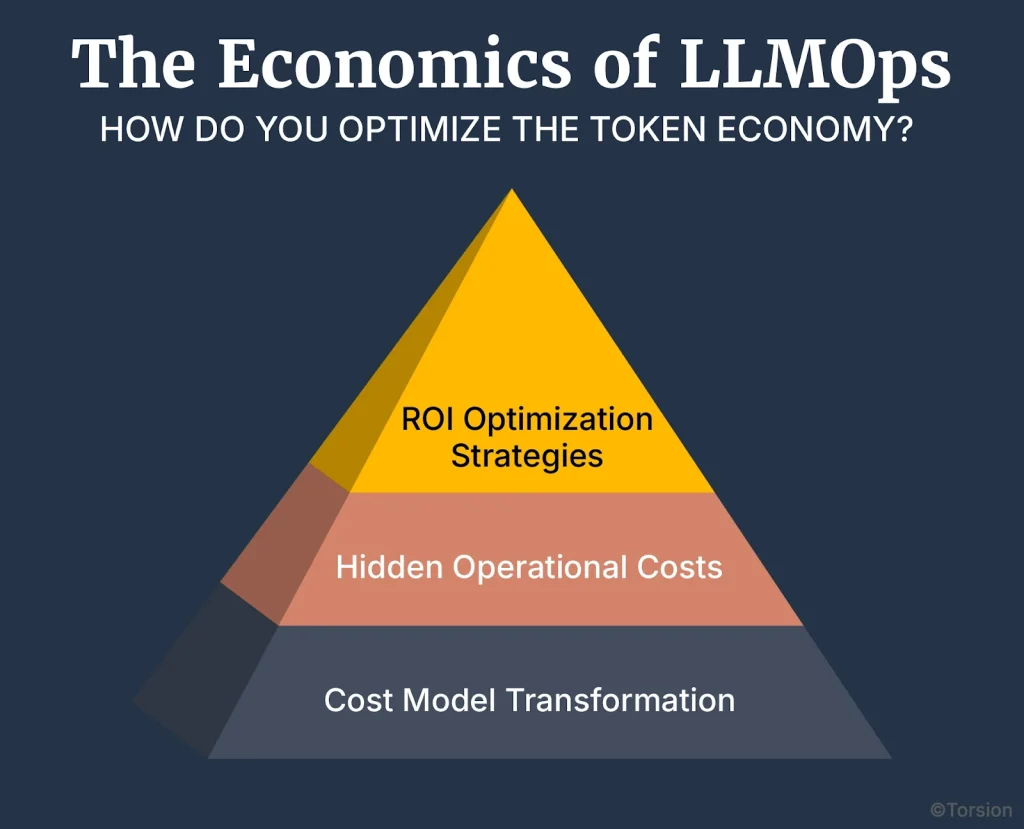
You’ve built the stack. The prompts are stable. The model behaves. But then finance calls.
Why is your monthly LLM spend up 38%?
In traditional MLOps, cost is buried and spread across training runs, infrastructure, and batch jobs. In LLMOps, it’s visible. It’s immediate. Every word the model generates is a transaction.
And in healthcare payer environments, where interactions are long, regulated, and high volume that adds up fast.
This is where LLMs stop being a technology discussion and become an economics one. The architecture has to be designed for efficiency and accuracy, not either or. Because in payer operations, volume is your baseline.
Cost Model Transformation
You don’t pay for models. You pay for conversations.
LLM pricing isn’t tied to compute time. It’s tied to tokens—input, output, and context. That shifts the cost center from infrastructure to interaction.
What payers need to implement
- Query complexity analysis: Don’t send every inquiry to your most expensive model.
- Semantic caching: Avoid reprocessing repeated prompts with nearly identical semantics.
- Dynamic context shaping: Prune unnecessary history in long member sessions.
- Progressive expansion: Use smaller models first, escalate only if needed.
Payer reality: A prior auth chatbot serving 100K members doesn’t need GPT-4 for every “Am I covered for X?” question. Model routing saves six figures fast.
Hidden Operational Costs
Your bill also includes the machinery behind the scenes.
The model is just one piece. The orchestration stack carries its own drag.
Where the hidden spend comes from
- State management: Keeping context between calls isn’t free. It’s memory, bandwidth, and engineering time.
- Continuous fine-tuning: New regulations? That means new data, new runs, and more overhead.
- Compliance logging: Every generated explanation might need to be stored, traced, and auditable.
- Human-in-the-loop integration: Escalations mean workflows, dashboards, and oversight teams.
Payer reality: If your model makes a coverage decision, you may need to store that explanation, and the prompt, for seven years. Welcome to the new audit trail.
ROI Optimization Strategies
You want control along with savings.
Cost reduction only matters if it’s tied to predictability and scale.
Key strategies for payer orgs
- Automated model routing: Match model size to query intent in real time.
- Predictive cost modeling: Estimate token use before you commit.
- Resource pooling: Share model usage across member services, appeals, and analytics.
- Performance-cost optimization: Tune not just for accuracy but efficiency per dollar.
Payer reality: Your 24/7 LLM service center should run like a call center with real dashboards showing cost per interaction, latency per model, and ROI by use case.
LLMOps in the Wild: Patterns, Governance, and What’s Next
LLMOps in production demands behavior control. Payers need systems that detect hallucinations, enable traceability, and integrate seamlessly with core operations. From model provenance to auto-escalation logic, governance is built-in. As LLMs scale, so do risks. Mature LLMOps ensures reliability, compliance, and explainability in real-time, member-facing healthcare environments.
In healthcare, LLMs don’t operate in isolation. They manage live conversations under regulatory pressure. Production-ready LLMOps means circuit breakers, rollback logs, audit trails, and policy-aware behavior. It’s the infrastructure behind trust. And it’s evolving: with autonomous ops, multi-agent flows, and early quantum integrations, the smartest payer orgs are building for what’s next, not just what works now.
You’ve built the architecture and optimized the economics. Now, comes the hard part.
In payer organizations, a model doesn’t live in a lab. It lives in production. Under load and scrutiny while talking to members, explaining policy, and handling escalations.
That means it has to perform, and also behave reliably, transparently, and safely.
This is the operational layer where it all converges. Where system design meets member experience. Where one unpredictable output can trigger a compliance audit, or worse, erode trust.
Here’s how production-grade LLMOps holds the line.
| Reliability and Safety PatternsPayers need uptime. But more importantly they need controlled behavior.Circuit breakers that detect hallucinations or toxic outputs and reroute to safe fallback systems Progressive rollouts that validate semantic correctness before full deployment Shadow mode testing to evaluate new models without impacting member experience Confidence-based escalation that auto-routes low-certainty responses to human reviewers Active learning loops that retrain on human-corrected responses Expert-system integration for high-risk use cases (e.g. appeals, denials) | Governance, Auditability, and ExplainabilityIn healthcare, trust is a regulation and an absolute must. Model provenance tracking from base model to fine-tune lineage Prompt attribution logs to trace what input led to what output Version rollback to recover from regressions instantly Training data disclosure and IP compliance especially when using third-party models Fairness monitoring across ZIP codes, age brackets, and care types Automated explanation generation to help humans and auditors understand how a model reached a decision |
| Integration and Infrastructure PatternsThe LLM shouldn’t be a separate system. It should be part of the flow.API gateway orchestration for routing member queries by type, intent, and priority Event-driven architecture that responds in real time to changes in claim state or auth decisions Microservices-based LLM modules to deploy models independently per use case Legacy integration patterns that augment rather than replace existing core systems | Future Patterns: Where It’s GoingOperational maturity is table stakes. Here’s what comes next.Autonomous LLMOps: Self-tuning inference parameters, auto-prompt drift detection, and dynamic safety filter updates Multi-agent orchestration: Coordinated LLM “teams” handling complex member journeys (benefits, claims, appeals, education) Quantum-classical hybrid workflows: Early-stage use in hyperparameter search and complex sampling for organizations investing in edge innovation |
Implementation Roadmap: What is Your Path to LLMOps Maturity?
Payers can’t operationalize LLMs overnight. This roadmap guides a phased rollout: from assessing MLOps compatibility to deploying guardrails, optimizing cost, and piloting multi-agent systems. Compliance, explainability, and behavior tracking must be built in early. By Year 2, leading orgs develop proprietary LLMOps layers and shape industry standards. Maturity equals scalability, safety, and sustained performance.
LLMOps isn’t plug-and-play, it’s a staged transformation. Start by stress-testing your MLOps setup. Then build muscle with guardrails, prompt tracking, and human-in-the-loop reviews. Next, optimize everything: cost per query, context size, inference tuning. Eventually, you’ll lead developing your own orchestration logic and setting the bar for the industry. Healthcare payers that scale wisely, win.
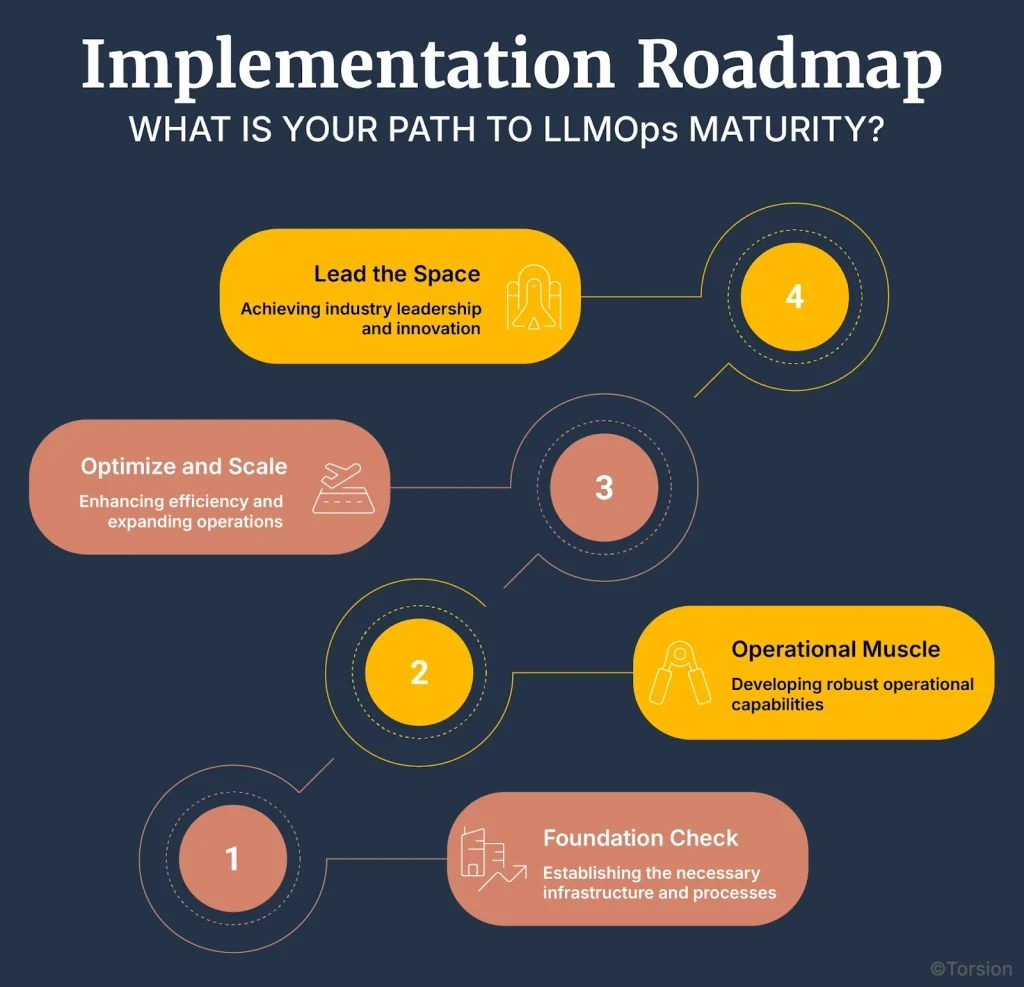
At this point, you’ve seen what’s required to make LLMs work in healthcare reliably, safely, and at scale. The tech is only half the battle. The other half? Operational fit.
This shift won’t happen overnight. But it doesn’t need to.
Most payers aren’t starting from zero. They already have pipelines, monitoring, and compliance teams. What they need now is a step-by-step path to bridge where you are and where this new operational model demands you go.
Phase 1: Foundation Check (Months 1–6)
Start where you are. Not where the vendors say you should be.
- Look at your current MLOps setup. What parts break when prompts enter the picture?
- Roll out basic prompt tracking just enough to see drift, not everything at once.
- Begin tracking token spend. You’ll need that baseline soon.
- Assess team gaps. Prompt design is not ML engineering. And compliance folks will need context.
Phase 2: Operational Muscle (Months 7–12)
Now it’s real. Time to build around reality, not demos.
- Add multi-modal support—EOBs, transcripts, chatbot logs all flow together.
- Stand up guardrails that catch hallucinations, tone shifts, and policy misreads.
- Create human review paths that aren’t just manual but integrated.
- Bake in compliance. Versioning, traceability, prompt logs. This stuff can’t be retrofitted later.
Phase 3: Optimize and Scale (Year 2)
You’ve got the pipes. Now make them smarter.
- Let your systems tune themselves where they can. Prompt logic, inference speed, context size.
- Automate explanation capture and output lineage especially for anything regulatory-facing.
- Try out multi-agent flows: one bot to summarize, another to cross-check against policy.
- Run the numbers. Cost per query. Token per interaction. Latency vs. accuracy. Tighten the loop.
Phase 4: Lead the Space (Year 2+)
This is where the front-runners pull away.
- Start testing quantum-enhanced workflows. Maybe it’s sampling. Maybe it’s search.
- Build your own LLMOps layer. The orchestration logic, the behavior scoring — make it yours.
- Help write the rules. Contribute to standards around provenance, explanation, safety.
- And share. Internally. Externally. The leaders will be the ones who shape the conversation.
What is the Competitive Advantage of Operational Excellence?
Every payer wants to innovate. Few are set up to operationalize it.
Deploying an LLM is easy. Keeping it compliant, consistent, and cost-effective? That’s the hard part.
That’s where most get stuck between a flashy pilot and a fragile rollout.
But here’s the upside: operational maturity is a moat. In healthcare, the payers who build the muscle to manage behavior, not just deploy models, will be the ones who move first, scale fast, and lead long-term.
That’s what LLMOps delivers. Not another Enterprise AI tool. Not just automation. A full-stack, real-time, enterprise-grade system for managing intelligence in the wild.
And the payoff? Safer decisions. Faster resolution. Lower overhead. Better member experiences. Plus the confidence to expand use cases without expanding risk.
You can’t predict everything an LLM will do. But with the right infrastructure, you don’t have to. You can guide it, govern it, and grow with it.
The future belongs to the operators. Those who can not only imagine what Enterprise AI can do, but run it, responsibly and at scale.



